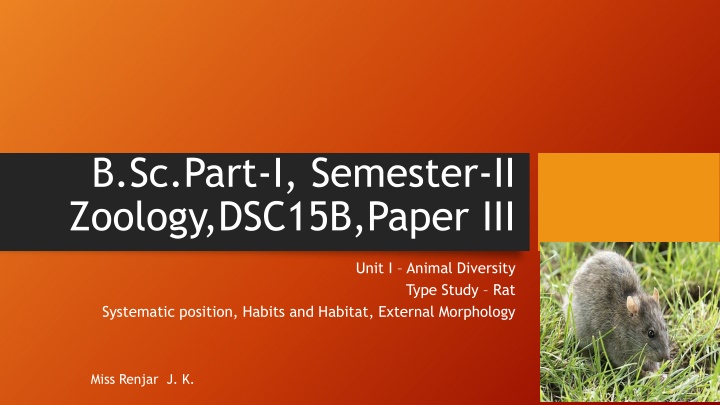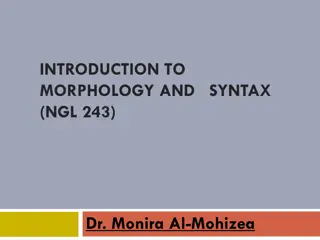Detailed Study of Rat's Systematic Position, Habitat, and External Morphology
Dive into the world of rats with a comprehensive exploration of their systematic position in the animal kingdom, nocturnal habits, burrow-dwelling behavior, and external morphology. Learn about the rat's reproductive patterns, average lifespan, and distinctive anatomical features from head to tail.
Download Presentation

Please find below an Image/Link to download the presentation.
The content on the website is provided AS IS for your information and personal use only. It may not be sold, licensed, or shared on other websites without obtaining consent from the author.If you encounter any issues during the download, it is possible that the publisher has removed the file from their server.
You are allowed to download the files provided on this website for personal or commercial use, subject to the condition that they are used lawfully. All files are the property of their respective owners.
The content on the website is provided AS IS for your information and personal use only. It may not be sold, licensed, or shared on other websites without obtaining consent from the author.
E N D
Presentation Transcript
B.Sc.Part-I, Semester-II Zoology,DSC15B,Paper III Unit I Animal Diversity Type Study Rat Systematic position, Habits and Habitat, External Morphology Miss Renjar J. K.
Systematic position Phylum Chordata Sub- phylum Vertebrata (Craniata) Division Gnathostomata Super Class Tetrapoda Class Mammalia Sub Class Placentalia Order Rodentia Genus Rattus Species rattus
Habits and Habitat Nocturnal in habits. Good climber and live in burrows near human dwellings. It is also found in store places and warehouse. Rat uses its burrows for rest, shelter, as a nursery for the young and for food storage. Rat was herbivorous animal. Food is various kinds of seed and grains. Rat damage clothes, books, papers, furniture and many other stored material. Rat is very prolific breeder.
The average life span is hardly three years. The rate of reproduction is high. Rat mature when it is 2 to 3 months old. It produces 4 to 5 litters a year. Each litter contains 4 to 10 young ones. A female rat produces about 30 young ones in an year.
External Morphology The body of Rat is soft, cylindrical and gradually tapering at the both ends. The body of Rat is broadly divisible Into head, neck, trunk and tail.
(a) Head The head is conical in shape. It is slightly compressed laterally. It tapers towards the anterior end and forms a pointed snout. The snout bears pair of nostrils It also bears a narrow mouth, having soft upper and lower lips. The snout bears long and stiff hairs which are sensitive. The eyes are situated one on either side of the head. Behind the eyes a pair of rounded external ears are present. (b) Neck The neck is short which joins the head to the trunk. It allows free movement to the head
(c) The Trunk It is elongated part which is divisible into thorax and abdomen. The thorax is the anterior part and abdomen is posterior part of trunk. The thorax is supported by ribs and a breast bone. The abdomen is without any support. The ventral side of abdomen is soft. The teats are present in female rat, three pairs on thoracic region and three pairs on abdominal region The trunk bears two pairs of limbs, fore limbs and hind limbs. The anus and the external sex organs are situated at the end of the trunk region. The external sex organs lie on the ventral side of the posterior region of the abdomen in front of the anus.
(d) The tail At the posterior end of the trunk there is a tail Tail is longer than trunk, cylindrical and gradually tapers towards posterior end. It covered by overlapping epidermal scales arranged in rings. The rat has about 210 rings on tail. The tail is used as a balancing organ.






















